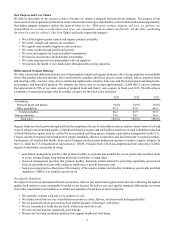Whole Foods 2013 Annual Report Download - page 21
Download and view the complete annual report
Please find page 21 of the 2013 Whole Foods annual report below. You can navigate through the pages in the report by either clicking on the pages listed below, or by using the keyword search tool below to find specific information within the annual report.12
those team members into the programs and policies of the Company. We may not be able to adapt our distribution, management
information and other operating systems to adequately supply products to new stores at competitive prices so that we can operate
the stores in a successful and profitable manner.
Economic conditions that adversely impact consumer spending could materially impact our business.
Our operating results may be materially impacted by changes in overall economic conditions that impact consumer confidence
and spending, including discretionary spending. Future economic conditions affecting disposable consumer income such as
employment levels, business conditions, changes in housing market conditions, the availability of credit, interest rates, tax rates,
fuel and energy costs, the impact of natural disasters or acts of terrorism, and other matters could reduce consumer spending or
cause consumers to shift their spending to lower-priced competitors. In addition, there can be no assurance that various
governmental activities to stimulate the economy will restore consumer confidence or change spending habits.
We may experience fluctuations in our quarterly results of operations, which may adversely affect our stock price.
Our quarterly operating results and quarter-to-quarter comparisons could fluctuate for many reasons, including, but not limited
to, price changes in response to competitive factors, seasonality, holiday shifts, increases in store operating costs, including
commodity costs, possible supply shortages, general economic conditions, extreme weather-related disruptions, and other
business costs. In addition, our results may be impacted by the timing of new store openings, construction and pre-opening
expenses; the timing of acquisitions, store closures and relocations; and the range of operating results generated from newly
opened stores.
Our stock price has been volatile and may be negatively affected by reasons unrelated to our operating performance.
In fiscal year 2013, the closing market price per share of our common stock ranged from $41.51 to $59.32. The market price of
our common stock could be subject to significant fluctuation in response to various market factors and events. These market
factors and events include variations in our sales and earnings results and any failure to meet market expectations; changes in
ratings and earnings estimates by securities analysts; publicity regarding us, our competitors, or the natural products industry
generally; new statutes or regulations or changes in the interpretation of existing statutes or regulations affecting the natural
products industry specifically; and sales of substantial amounts of common stock in the public market or the perception that
such sales could occur and other factors. In addition, the stock market, at times, experiences broad price fluctuations that may
adversely affect the market price of our common stock.
Adverse publicity may reduce our brand value and negatively impact our business.
We believe our Company has built an excellent reputation as a food retailer, socially responsible corporation and employer, and
we believe our continued success depends on our ability to preserve, grow and leverage the value of our brand. Brand value is
based in large part on perceptions of subjective qualities, and even isolated incidents can erode trust and confidence, particularly
if they result in adverse publicity, governmental investigations or litigation, which can negatively impact these perceptions and
our business. In addition, our brand and reputation could be harmed by actions taken by our suppliers that are outside of our
control.
Changes in the availability of quality natural and organic products could impact our business.
We source our products from a variety of local, regional, national and international suppliers, and we rely on them to meet our
quality standards and supply products in a timely and efficient manner. There is, however, no assurance that quality natural and
organic products will be available to meet our needs. If other competitors significantly increase their natural and organic product
offerings, if new laws require the reformulation of certain products to meet tougher standards, or if natural disasters or other
catastrophic events occur, the supply of these products may be constrained.
Disruption of significant supplier relationships could negatively affect our business.
United Natural Foods, Inc. (“UNFI”) is our single largest third-party supplier, accounting for approximately 32% of our total
purchases in fiscal year 2013. Due to this concentration of purchases from a single third-party supplier, the cancellation of our
distribution arrangement or the disruption, delay or inability of UNFI to deliver product to our stores may materially and adversely
affect our operating results while we establish alternative distribution channels.
Future events could result in impairment of long-lived assets, which may result in charges that adversely affect our results of
operations and capitalization.
Our total assets included long-lived assets totaling approximately $2.5 billion as of September 29, 2013. Long-lived assets are
evaluated for impairment whenever events or changes in circumstances indicate that the carrying amount of an asset may not
be recoverable. Our impairment evaluations require use of financial estimates of future cash flows. Application of alternative
assumptions could produce significantly different results. We may be required to recognize impairments of long-lived assets
based on future economic factors such as unfavorable changes in estimated future undiscounted cash flows of an asset group.
























